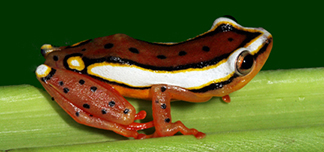| Publication Type: | Journal Article |
| Year of Publication: | 1998 |
| Authors: | A. E. Feller, S. Hedges B. |
| Journal: | Molecular Phylogenetics & Evolution |
| Volume: | 9 |
| Pagination: | 509-516 |
| Date Published: | June |
| Abstract: | The evolutionary relationships of the three orders of living amphibians (lissamphibians) has been difficult to resolve, partly because of their specialized morphologies. Traditionally, frogs and salamanders are considered to be closest relatives, and all three orders are thought to have arisen in the Paleozoic (>250 myr). Here, we present evidence from the DNA sequences of four mitochondrial genes (2.7 kilobases) that challenges the conventional hypothesis and supports a salamander-caecilian relationship. This, in light of the fossil record and distribution of the families, suggests a more recent (Mesozoic) origin for salamanders and caecilians directly linked to the initial breakup of the supercontinent Pangaea. We propose that this single geologic event isolated salamanders and archaeobatrachian frogs on the northern continents (Laurasia) and the caecilians and neobatrachian frogs on the southern continents (Gondwana). Among the neobatrachian frog families, molecular evidence supports a SouthAmerican clade and an African clade, inferred here to be the result of mid-Cretaceous vicariance. |
| URL: | file://localhost/Users/breda/Desktop/Literature/F/Feller.pdf |
